Diving the
Skafandro suit
Copyright © by Sandra Hendrikse and André Merks
Translation and layout: Bert Dodde
With it's size of about 8 by 16 kilometers Kalymnos is
a fairly small island in the Aegean Sea. It is part of the Dodekanesos, a group
of over 50 islands in the southeast of Greece.
Although sponge diving was a source of income for
several Greek islands during the last centuries, Kalymnos is known to be the
center of the Greek sponge diving industry. The waters around the Greek islands
are very suitable for the sponges to grow, because of the high temperature. The
best sponge quality is found in the southeast of the Mediterranean sea.
|
It is unknown when exactly the sponge became an article
of use. In ancient writings (Plato, Homerus) the sponge is mentioned as an
object used for bathing. In Kalymnos also sponge diving had it's roots in
ancient times. It can be seen as the oldest profession on the island. Diving for
sponges brought social and economical development to the island.
In the old days the "skin diving"
method was used. The crew went out to sea in a small boat. They used a
cilyndrical object with a glass bottom to search the ocean floor for
sponges. As soon as one was found, a diver went overboard to get it. He
was usually naked and carried a 15 kilogram flat stone, known as the
"skandalopetra" with him to take him down to the bottom quickly. The
diver then cut the sponge loose from the bottom and
put a special net around it. Depth an bottom time depended on the divers
lung capacity. They usually went down to about 30 meters for 3 to 5
minutes.
|

|
Although this was very hard work, this way of diving
brought so many sponges to the island that the trade from Kalymnos expanded in a
great way around 1800. Half-way the 19-th century Kalymnos had several merchants that
became very wealthy. Through the big profits they made on the sponges they also
gained a big influence on the social life on the island.
|
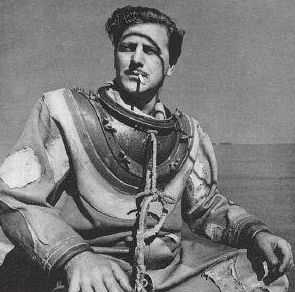
|
As from
1865 trading sponges became "booming business". The reason for
this was the introduction of the standard diving suit or Skafandro as the
Greeks call it. A merchant from the island of Symi brought equipment,
probably Siebe Gorman, to the island. The advantages seemed enormous. Now,
divers could stay down as long as they wanted in greater depths. The best
sponges could be found at depths of about 70 meters. A diver could now
walk on the ocean floor and look for them.
|
In her book "Bitter
Sea", Faith Warn discribes that in 1868 the sponge diving fleet
consisted of:
- 300 ships with divers (6 to 15 divers on each ship)
- 70 ships that harvested sponges with harpoons
- 70 trawlers
| Due to the
standard suit the sponge trade got an unlimited growth. From
Kalymnos, ships sailed the Aegean sea and the Medeterranean sea. They went
as far as Tunisia, Libya, Egypt, Syria and Lebanon. They stayed out at sea
for at least 6 months.
The profit on the sponges was high. For the
divers the working circumstances were better than diving naked. However,
there was a big danger in staying down deep for long times: decompression
sickness. soon after the standard suit was introduced, the first
casualties appeard. The symptoms, heavy pain, paralysis and eventually
death must have been terrifying for divers and other crew because they did
not have a clue what caused all this !
A combination of several dives a day to depths up
to 70 meters and then coming up without decompression stops did not miss
its devastating effect: in the first years the standard suit was used,
about half of the divers got paralised or died of decompression sickness.
In her book "Bitter
Sea", Faith Warn discribes that between 1886 and 1910 about 10.000
divers died and 20.000 got pemanently disabled.
|
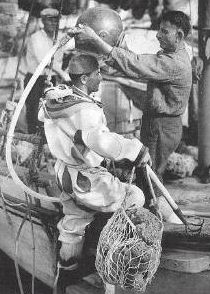
Picture above for illustration purposes
only,
picture actually from Tarpon Springs, Florida.
|
This was also of big influence on all the people on
Kalymnos. Every family had fathers, sons, brothers or other relatives that were
paralised or never returned from the sponge diving season. By the end of the
19th century this caused big anxiety on Kalymnos, especially among women. In
those days Kalymnos was ocupied by the Turks. The women asked the Turkish sultan
to forbid the standard diving suit, which he did in 1882. Profits dropped: the
divers had to go "skin diving" again. About 4 years later the suit was
back and so were the decompression accidents.
|
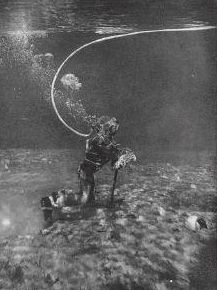
|
It is easy
to understand why the divers used the standard suit not knowing the
dangers: The knowledge of decompression and decompression sickness
developed in the 19th century. The studies used sponge diver experiences
as input. The first workable decompression table came available around 1910.
After that it took several years to get the knowledge to the remote Greek
islands. Decompression tables could not prevent all diving accidents. The
first tables did not cover repeated dives and the sponge divers made
several repeated dives each day.
As
soon as they found out how important the bottom time was to prevent
accidents the bottom time was kept by somebody aboard the ship. They used
an hour-glass for this that was not very accurate.
|
Sponge diving brought wealth to the island but took a
lot of lives as well. In the beginning only the merchants profited from it,
later the whole community. Health care and education came available for
everybody for free. The merchants posessed the fleet, the factories,
restaurants, bars and a factory on Kalymnos were standard diving equipment was
produced. English standard diving equipment was copied. Thus, the equipment was
cheap and easy to maintain and repair. Spare parts were available on their own
island. The "Xyth Pio" factory produced standard diving equipment for
many years.
In the beginning of the 20st century the sponge diving
industry had hard times in the Dodekanesos. Around 1900 the growth got to her
maximum and both worldwars caused limitations to the trade. From Kalymnos and
other islands like Halki and Symi large groups of divers settled in other parts
of the world to do what they did best: diving. Around 1905 a group of
about 500 divers from the Dodekanesos settled in Tarpon Springs, Florida, USA.
These days diving helmets are still made by Nicolas
Toth. Nic is the grandson of Antonios Lerios, born on Kalymnos, who settled
in Florida in 1913 as a helmet maker.
After
the second world war the sponge diving industry almost completely stopped
in the Dodekanesos. In those days Australia refused to work together with
Japanese divers in the pearl industry. Therefore many Greek divers settled
in Australia.
Many people feel that the introduction of the
synthetic sponge ment the end for the sponge diving industry. The biggest
problem however, occured in 1986. Nearly all the sponges in the Aegean sea
turned out to be infected. The cause of this never became clear. A sudden
rise of the water temperature could be the cause. Similar infections
appeard in the Gulf of Mexico in the 1940's 70's and
90's.
Anno 2001 there is hardly anything left of the
sponge diving fleet from 1868. From 400 ships, about 10 to 15 are left. In
recent years the sponges in the waters around Kalymnos have recovered in a
great way. However, local sponge divers announced that they encountered
infected sponges again in october 2000.
|
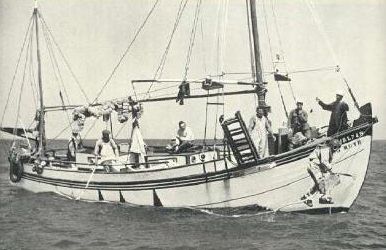 |
 |
Some sponge diving witnesses can be found on some Greek
islands. The capital of Kalymnos, Pothia, has a number of workshops left were
sponges are cut and sold. In the harbour, a nautical museum has a display on
sponge diving. The helmets you see in the previous page are in this exhibition.
Vlihadia, a little town close to Pothia holds the "Sea World Museum".
The privat collection of the Valsamidi brothers. |
| Sponge diver in
full action. The use of standard diving equipment stopped in the 1970's.
Many helmets were then sold as scrap-iron ! Still there are some divers in
the sponge diving business. They now wear neoprene suits and a diving
mask. They hold a mouthpiece between their teeth. This is attached to a air
hose that leads to a compressor on the boat. |
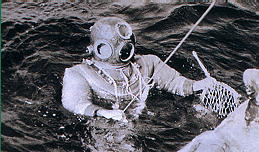
|
|
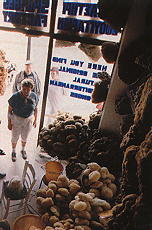
|
One of the many
sponge shops you can still find on Kalymnos today. Due to pollution and
huge harvesting there are hardly any Mediterranean sponges left. Tourists
go home with the higher quality (and more expensive) Greek sponges or with
Caribbean and Philippinean sponges that the Greeks import to
sell. |
If you want to know more about Greek sponge diving and
about the effects that it had on the community of Kalymnos we would like to
recommend two books:
Mrs. Charmian Clift & Mr. George Johnston (1955), The sponge divers, pub.
Lond. Collins. (Fiction !)
Warn, Faith (2000), Bitter Sea, The real story of Greek Sponge Diving,
Guardian Angel Press, South Woodham Ferrers. (Non-fiction, many good facts and
photos)
See
some fantastic hats in the Greek helmet collection
- Last update: 12th May 2009







